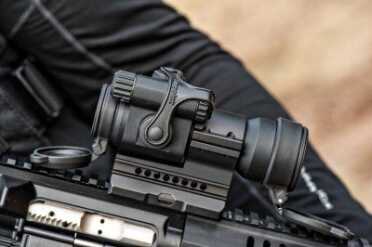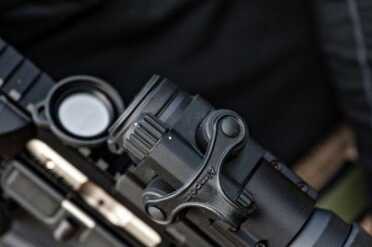By Steve Coulston
Images by Jody Lewis (CROSSFIRE Photography)
https://www.aimpoint.com/us/
Introduced at SHOT Show 2011, the Aimpoint Patrol Rifle Optic (PRO) entered the competitive red dot market with a host of features designed specifically for the Law Enforcement Officer (LEO). Aimpoint, which has been in the red dot business since 1974, took its years of experience as well as input from LEO professionals to create an optic that is optimized for the LEO mission field and the LEO wallet. The features of the PRO are vast, and while Aimpoint has other red dot optics in its product inventory that may appear comparable, none could match the MSRP of $440.
The catch, at the time, was it was specifically made for LEO and could only be bought from an authorized Aimpoint Dealer. Of course with that kind of price point for a top-notch optic, everyone wanted to get his hands on one (or four). The general public was initially frustrated by the lack of availability, but Aimpoint wanted to make sure the LEO community was the first to get the PRO. Some civilians (like me) were able to get the PRO from other sources a few months down the road, but pickings were slim and disappeared very quickly. Eventually, like everything, the mystique of the optic and its “unobtainable” status faded away. Aimpoint now offers the PRO as part of its commercial line, available to the American shooting public. Even as we enter 2014, the Aimpoint Patrol Optic is still one of the most affordable, well-rounded and robust red dots on the market. I have used red dot optics that are lighter and smaller, but for my money it is hard to beat the PRO for what you get.
The main reasons I keep coming back to Aimpoint are the advanced technology and durability. The PRO has both. The PRO uses Advanced Circuit Efficiency Technology (ACET), which means the 2 MOA LED red dot will stay on for 30,000 hours. That is over three years of constant on-time using the same 3V 2L76 or DL1/3N battery. This allows the LEO to always have the optic on, so there is one less thing to think about in an emergency situation. Also, this optic can take a beating. At first glance, the discerning Aimpoint connoisseur would notice the PRO looks similar to the venerable CompM2. The PRO uses the familiar, rugged 30mm, hard anodized aluminum tube. The tube is sealed and is water resistant down to 150 feet, and it can operate in temperatures from -50 degrees to 160 degrees Fahrenheit.The lenses are recessed in the tube to prevent damage against dynamic impacts a LEO may inflict on the optic during a room search. The recesses are also threaded for the installation of kill flashes (front) or specialized prescription lens inserts (rear) if desired. The optic also comes with front and rear flip covers. The covers can be rotated so they can flip either up or down. Personally, I prefer the covers to flip down, which is one less thing in my field of view. The rear cover is clear while the front is opaque. This was done for a few reasons. First, the clear rear cover allows to user to see the red dot and target EVEN with the front cover closed. Our brains are smart and can complete the picture using our support eye and superimpose the red dot onto the target with our optic eye. This allows the LEOs to keep the always-on optic protected while in storage, yet instantly available, even if they forget to flip the lenses caps in a high-stress situation. The solid front cap is provided so the users can write on the inside face, making note of the optics in service date and when they turned the optic on. This will serve as a reminder as to when the batteries should be changed.
The 30mm tube is securely clamped to a modular QRP2 mount that is designed specifically for the now-standard 1913 Picatinny rail. This mount has a removable spacer that allows the optic to be co-witnessed with standard-height AR iron sights. When the spacer is removed, the Pro will sit low on a shotgun or sub-gun. This application can also be used on other rifles with a rail mounting elevation higher than the standard AR. The beautiful thing about the QPR2 mount is it has a torque-limiting knob that will provide the optimal amount of pressure to the rail interface. It is easy to over-tighten an optic, which risks damaging not only the gun but the optic as well. The QPR2 mount eliminates that risk. The knob can also be utilized on the left or right sides. This allows the user to get the knob out of the way for side-charged weapons, such as the IWI Tavor. I used the PRO in this gun and found it very helpful to have the knob on the right side, as the charging handle is on the left side.
The mount uses the same amount of torque for every install. This assures the optic is secured to the rail the same way every time. This is important for maintaining repeat zero. Typically, if I zero an optic, I don’t like to take it off, but for some reason if I have to, I am confident my point of impact will not shift with the PRO. Of course if you remove the optic, it is always a good idea to verify with your irons that it still co-witnesses and, if you have the ability, verify it on the range. I have found that with my eyes at a 50 yard zero, if there was a POI shift, it was so negligible I didn’t notice it. At longer ranges, the POI differences would be enhanced. It should be noted the dot is adjusted for windage and elevation via adjustment knobs at the 12 and 3 o’clock positions. Each adjustment click equals 1/2 inch POI at 100 yards. These adjustments can be made with a coin, rim of a round or flat head driver. The knobs are protected by aluminum caps which are tethered to the optic by a rubber strap.
The 2 MOA dot provides the user with zero parallax error, meaning you don’t need to center the dot. Simply place the dot on the target and fire. This makes for extremely fast, two-eyes-open target acquisition and is why red dots are so widely used in the military and LEO communities as well as civilian competition, hunting and other shooting sports. The 2MOA dot and mounting height on an AR make it ideal for using a magnifier. The Aimpoint magnifier sits perfectly behind the optic, providing 3X magnification without over-enlarging the 2 MOA dot. I have found that with larger dots, it becomes difficult to use a magnifier because the dot size gets a little unruly under magnification. Not so with the PRO. The PRO also has six daylight settings and four night vision settings. The settings can be adjusted manually via a knob located at the one o‘clock position of the optic. The range of adjustment, combined with the wide field of view, makes picking up the dot easy in any lighting condition. The clear rear lens cover allows the cover to stay on and the magnifier to be very close to the rear of the optic without using up valuable rail-estate. This works well with the Aimpoint twist mount or other aftermarket flip to side mounts like my favorite FTS by Larue Tactical.
Shooting the Aimpoint PRO is similar to any other red dot. It is simple and easy. I have shot the PRO on ARs as well as the IWI Tavor. The PRO isn’t a small optic, and at 11.6 oz (with mount and spacer) and 5.1 inches it does take up more rail-estate than other optics I have used in the past. It will eat up 8 spaces on your rail, but with the continuous rail platforms on ARs these days it isn’t much of an issue. The Tavor, however, was a different story. There isn’t as much top rail on the bullpup, but I was able to place both the PRO and the Aimpoint magnifier on the gun, leaving just enough room for the integral flip up sights to work should they be needed. It took a few tries to get it right, but in the long run it fit (barely). The optic was easy to zero and rounds on target were consistent and with the magnifier the groupings tightened up as would be expected. Obviously, as this is a true red dot, there isn’t a built-in bullet drop compensator (BDC), so you will need to figure out your hold-over at whatever distance you want to shoot at, but that is normal for all red dots.
If there were one item I would change with the PRO, it would be the battery type and location of its housing. The 2L76 battery isn’t always readily available for purchase. A standard AA or AAA battery could be a better, more common choice that is very plentiful and cheap. Also, the location is somewhat in my field of view. I would prefer the battery housing to be either at the five o’clock position or the seven o’clock position to get it down and out of the way. Aimpoint did this with the CompM4 and re-named it the CompM4s. This is a much better solution in my opinion.
Overall, the Aimpoint PRO is a winner. It incorporates Aimpoint reliability in an easy-to-use package. The best part for those of us on a budget is that it’s affordable. I purchased my first PRO a few years back for $350 brand new. There is no reason to sacrifice reliability just to save a few bucks, nor do you need to break the bank for a quality red dot optic. The Aimpoint Pro solves that problem in spades. For now, the PRO will stay atop my Tavor, but I would happily buy another to outfit my other guns. As an optic that was originally made for those who serve and protect on a daily basis, I am very confident it will do the same for those of us who don’t wear the badge. Well done, Aimpoint.






did you mention where it was manufactured? i prob misssed it in the article…